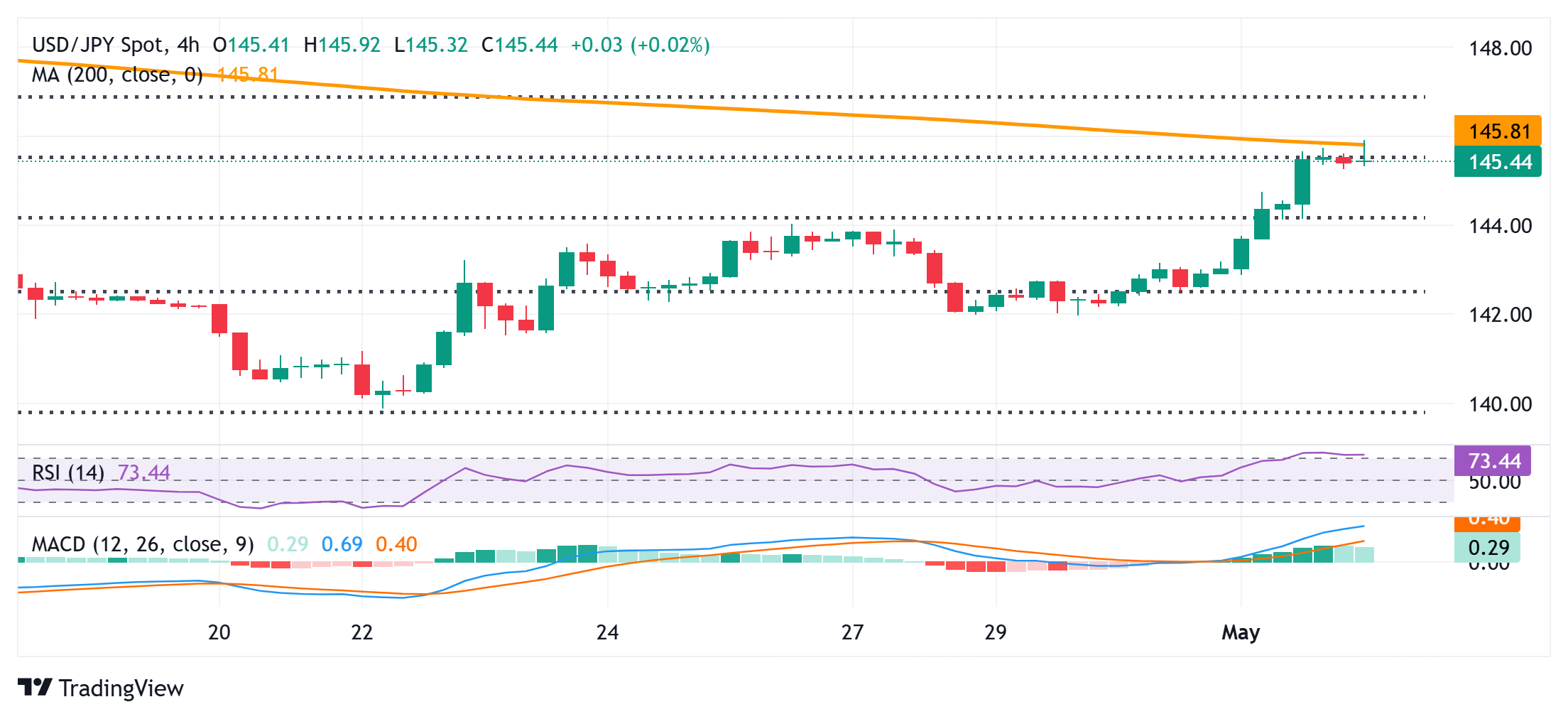- The Japanese Yen drifts lower for the fourth successive day against its American counterpart.
- The BoJ’s dovish outlook and a positive risk tone continue to undermine the safe-haven JPY.
- The USD preserves its gains to a multi-week high and also lends support to the USD/JPY pair.
The Japanese Yen (JPY) continues to be undermined by the Bank of Japan’s (BoJ) dovish pause the previous day and drops to over a three-week low against its American counterpart during the Asian session on Friday. In fact, the BoJ slashed its forecasts for economic growth and inflation for the current year amid heightened uncertainty over US trade tariffs. Investors were quick to react and pared their bets on further interest-rate hikes. Apart from this, the optimism over the potential de-escalation of the trade war between the US and China – the world’s two largest economies – undermines the safe-haven JPY.
Meanwhile, hopes for tariff deals between the US and its trading partners remain supportive of a positive risk tone. This, along with an unexpected uptick in Japan’s unemployment rate, weighs on the JPY. Moreover, the recent rise in the US Treasury bond yields assists the US Dollar (USD) to stand firm near a multi-week top and turns out to be another factor pushing the USD/JPY pair higher for the fourth straight day. However, prospects for more aggressive policy easing by the Federal Reserve (Fed) might cap the USD and lend some support to the lower-yielding JPY ahead of the US Nonfarm Payrolls (NFP) report.
Japanese Yen continues to be weighed down by BoJ’s dovish pause on Thursday and a positive risk tone
- The Bank of Japan, as was widely anticipated, kept short-term interest rates steady at 0.5% and struck a cautious tone by slashing its growth and inflation forecasts. The central bank expects the Japanese economy to grow 0.5% in the current fiscal year versus its earlier projection of 1.1% in January and revised down its core CPI forecast from 2.4% to 2.2% for fiscal 2025.
- In the post-meeting press conference, BoJ Governor Kazuo Ueda said that the uncertainty from trade policies heightened sharply and the timing to achieve the 2% inflation goal will be somewhat delayed. This forced investors to scale back their bets for the next BoJ interest rate hike in June or July and dragged the Japanese Yen lower for the fourth straight day on Friday.
- The BoJ, however, reiterated that it remains committed to raising interest rates further if the economy and prices move in line with its forecasts. This, however, does little to impress the JPY bulls amid the latest optimism fueled by hopes for US-China trade negotiations, which remains supportive of a generally positive tone across the global equity markets.
- In fact, China’s state media said on Thursday that US President Donald Trump’s administration had used various channels to contact Beijing and had been seeking to initiate tariff negotiations. The statement follows Trump’s assertions that conversations between the two nations were already underway – a claim that China has publicly denied repeatedly.
- Japan’s Finance Minister Katsunobu Kato said this Friday that the country’s $1 trillion-plus in US Treasury holdings are among the tools available to use in trade negotiations with the US. Kato also said his meeting with US Treasury Secretary Scott Bessent last week did not discuss any desirable level of exchange rates or a possible framework to control currency moves.
- On the economic data front, a report published by Japan’s Statistics Bureau earlier today showed that the Unemployment Rate edged up to 2.5% in March from 2.4% in the previous month. However, Japan’s average Unemployment Rate in fiscal 2024 fell 0.1% from a year earlier, to 2.5%, marking the first improvement in two years on the back of a labor shortage.
- From the US, the Department of Labor reported on Thursday that initial jobless claims increased from 223,000 to 241,000 in the week ended April 26 – marking the highest level since February. Moreover, the US ISM Manufacturing PMI remained firmly in contraction territory for the second straight month, though it fell less than expected, from 49.0 to 48.7 in April.
- This comes on top of the disappointing US ADP report on private-sector employment and points to signs of a cooling labor market. Adding to this, a surprise contraction in the US GDP for the first time since 2022 and easing inflationary pressures continue to fuel speculations for more interest-rate cuts by the Federal Reserve later this year.
- The US Dollar, however, seems unaffected and looks to build on a three-day-old uptrend to a three-week top, which, in turn, pushes the USD/JPY pair to the 146.00 neighborhood during the Asian session on Friday. Traders now look forward to the closely-watched US Nonfarm Payrolls report for cues about the Fed’s policy outlook and some meaningful impetus.
USD/JPY bulls now await a move beyond the 200-period SMA on the 4-hour chart before placing fresh bets

From a technical perspective, the overnight breakout above the 38.2% Fibonacci retracement level of the March-April downfall and the 145.00 psychological mark was seen as a key trigger for bullish traders. Moreover, oscillators on the daily chart have just started gaining positive traction and suggest that the path of least resistance for the USD/JPY pair is to the upside. The subsequent move up beyond the 50% Fibo. level, however, stalls near the 200-period Simple Moving Average (SMA) on the 4-hour chart.
This makes it prudent to wait for some follow-through buying beyond the 146.00 mark before positioning for an extension of the recent goodish recovery move from a multi-month low. Spot prices might then climb to the 146.55-146.60 intermediate resistance before aiming to test the 61.8% Fibo. level, around the 147.00 neighborhood.
On the flip side, the 145.25 area could offer immediate support ahead of the 145.00 round figure. Any further corrective slide might now be seen as a buying opportunity and remain limited near the 144.30-144.25 region, or the 38.2% Fibo. level. A convincing break below the latter, however, might prompt some technical selling and drag the USD/JPY pair below the 144.00 mark, towards the mid-143.00s en route to the 143.20 area and eventually to sub-143.00 levels.
Japanese Yen FAQs
The Japanese Yen (JPY) is one of the world’s most traded currencies. Its value is broadly determined by the performance of the Japanese economy, but more specifically by the Bank of Japan’s policy, the differential between Japanese and US bond yields, or risk sentiment among traders, among other factors.
One of the Bank of Japan’s mandates is currency control, so its moves are key for the Yen. The BoJ has directly intervened in currency markets sometimes, generally to lower the value of the Yen, although it refrains from doing it often due to political concerns of its main trading partners. The BoJ ultra-loose monetary policy between 2013 and 2024 caused the Yen to depreciate against its main currency peers due to an increasing policy divergence between the Bank of Japan and other main central banks. More recently, the gradually unwinding of this ultra-loose policy has given some support to the Yen.
Over the last decade, the BoJ’s stance of sticking to ultra-loose monetary policy has led to a widening policy divergence with other central banks, particularly with the US Federal Reserve. This supported a widening of the differential between the 10-year US and Japanese bonds, which favored the US Dollar against the Japanese Yen. The BoJ decision in 2024 to gradually abandon the ultra-loose policy, coupled with interest-rate cuts in other major central banks, is narrowing this differential.
The Japanese Yen is often seen as a safe-haven investment. This means that in times of market stress, investors are more likely to put their money in the Japanese currency due to its supposed reliability and stability. Turbulent times are likely to strengthen the Yen’s value against other currencies seen as more risky to invest in.

